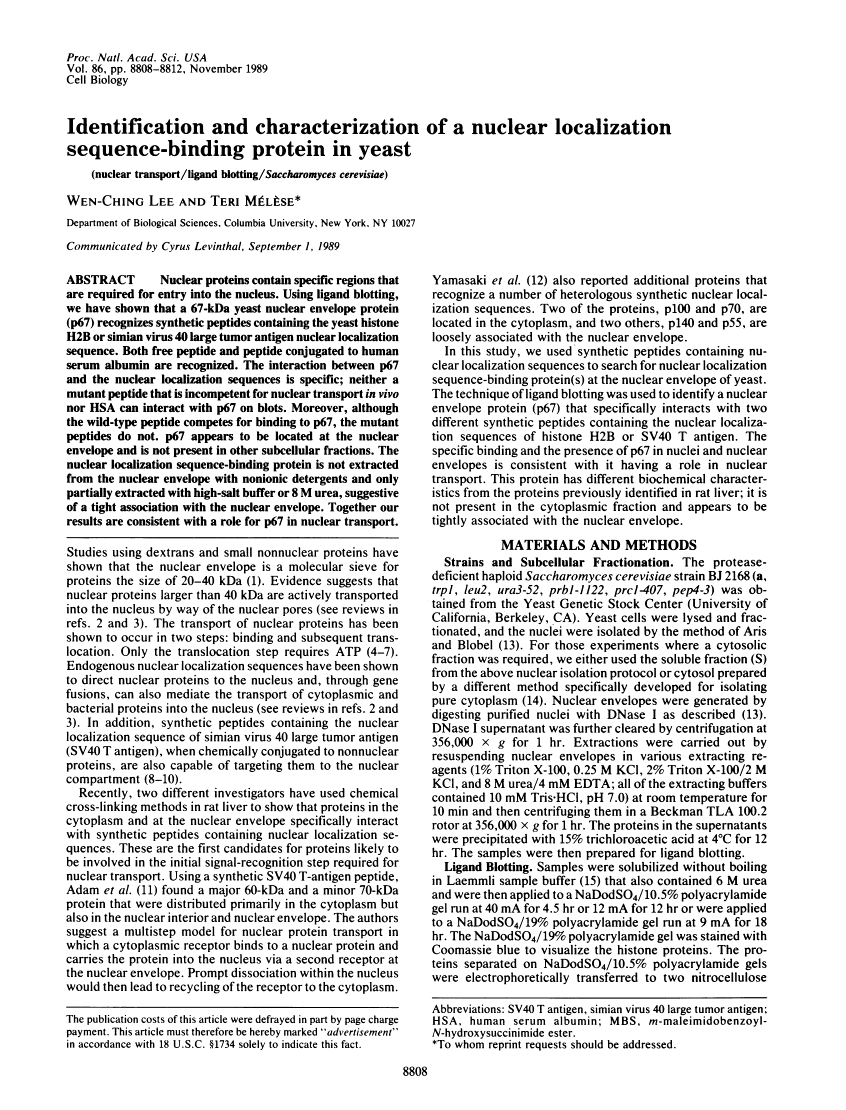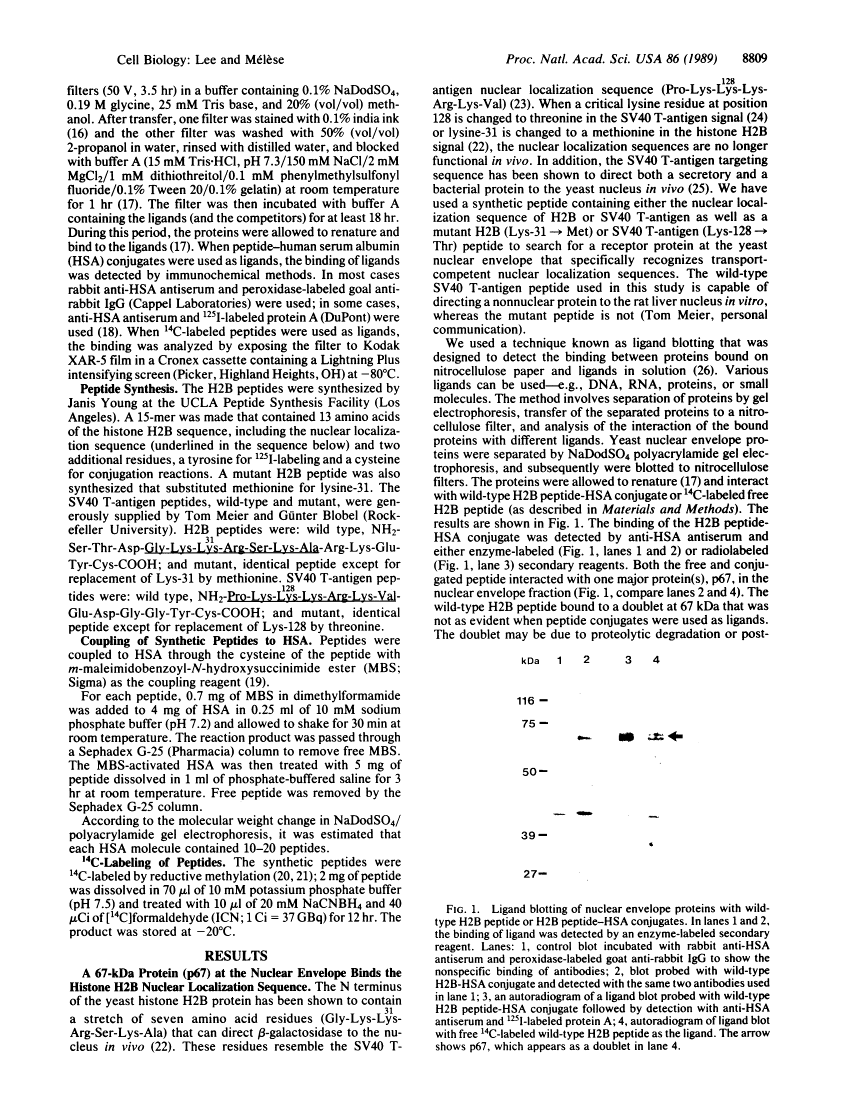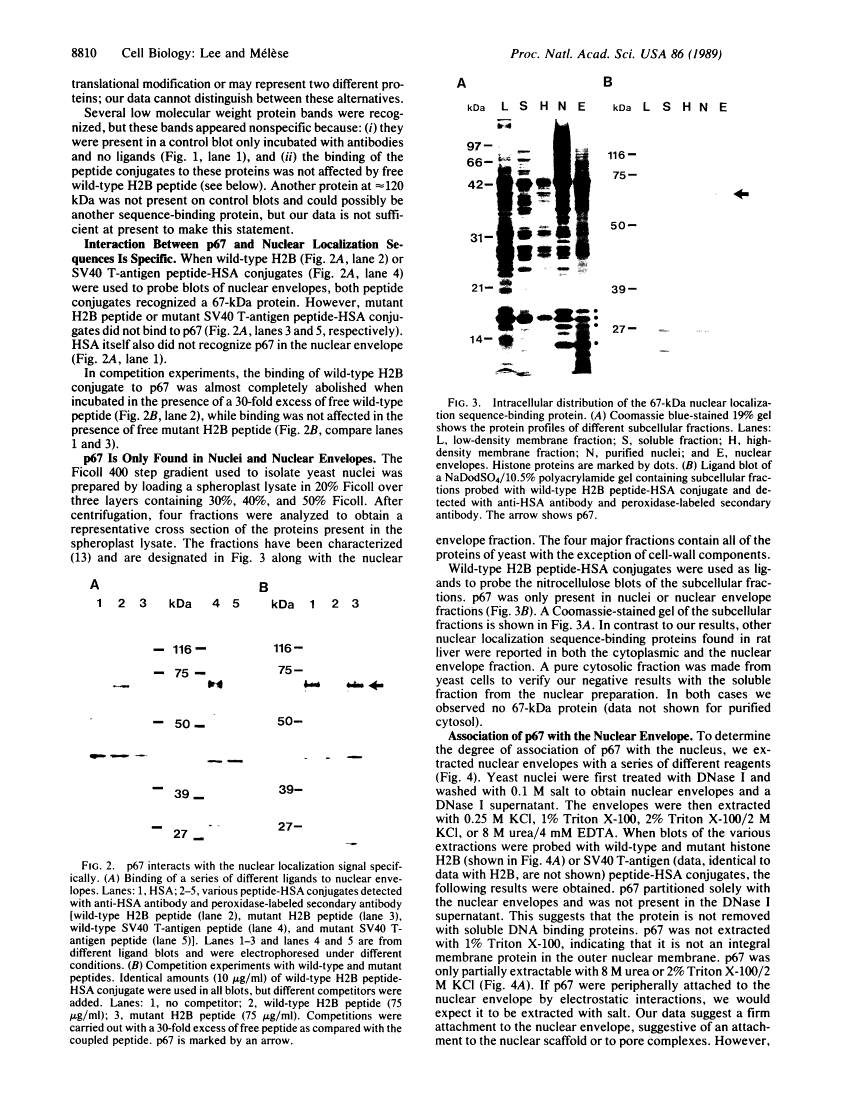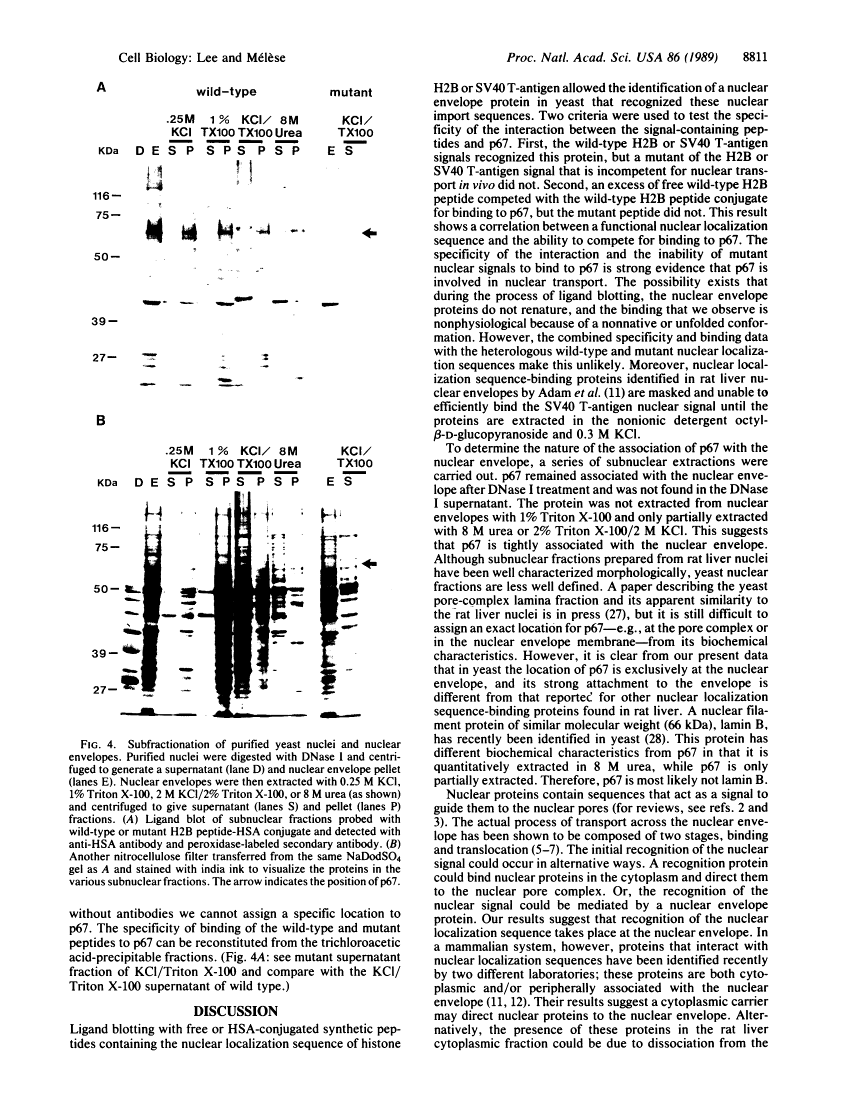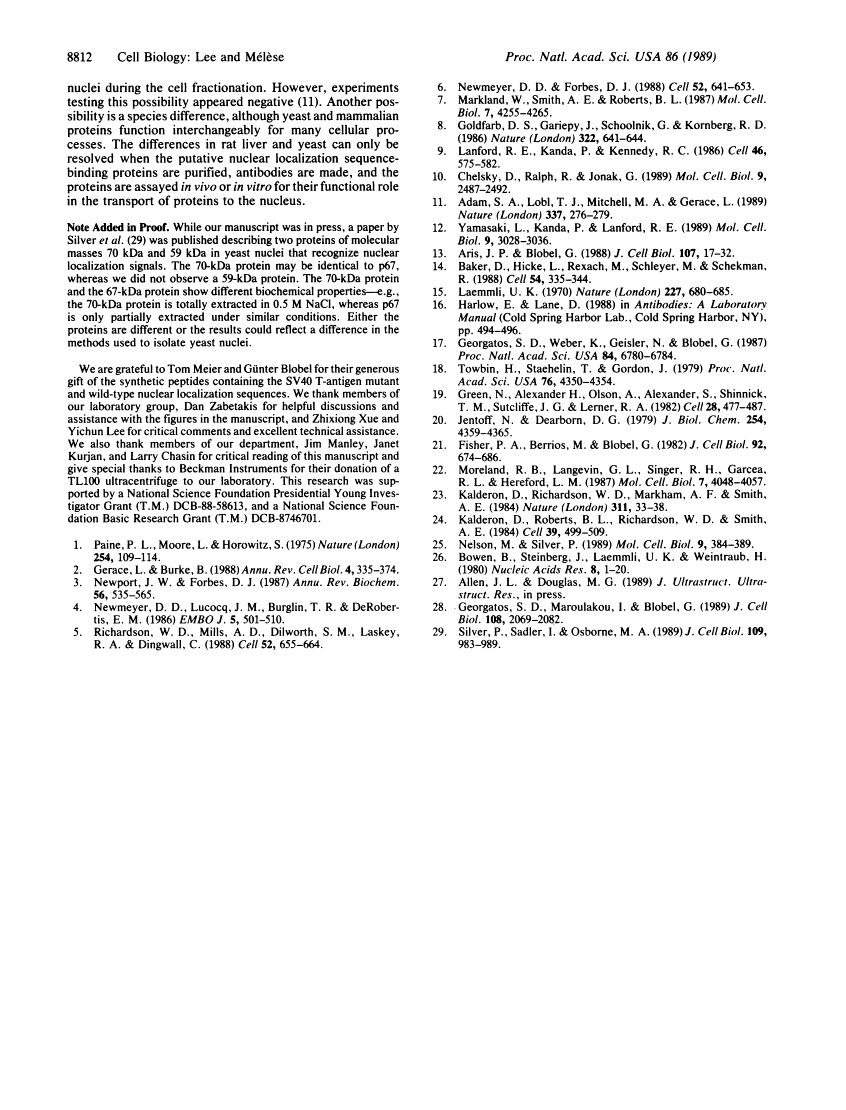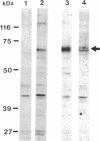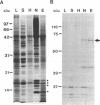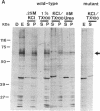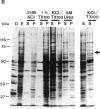Abstract
Free full text

Identification and characterization of a nuclear localization sequence-binding protein in yeast.
Abstract
Nuclear proteins contain specific regions that are required for entry into the nucleus. Using ligand blotting, we have shown that a 67-kDa yeast nuclear envelope protein (p67) recognizes synthetic peptides containing the yeast histone H2B or simian virus 40 large tumor antigen nuclear localization sequence. Both free peptide and peptide conjugated to human serum albumin are recognized. The interaction between p67 and the nuclear localization sequences is specific; neither a mutant peptide that is incompetent for nuclear transport in vivo nor HSA can interact with p67 on blots. Moreover, although the wild-type peptide competes for binding to p67, the mutant peptides do not. p67 appears to be located at the nuclear envelope and is not present in other subcellular fractions. The nuclear localization sequence-binding protein is not extracted from the nuclear envelope with nonionic detergents and only partially extracted with high-salt buffer or 8 M urea, suggestive of a tight association with the nuclear envelope. Together our results are consistent with a role for p67 in nuclear transport.
Full text
Full text is available as a scanned copy of the original print version. Get a printable copy (PDF file) of the complete article (1.3M), or click on a page image below to browse page by page. Links to PubMed are also available for Selected References.
Images in this article
Click on the image to see a larger version.
Selected References
These references are in PubMed. This may not be the complete list of references from this article.
- Paine PL, Moore LC, Horowitz SB. Nuclear envelope permeability. Nature. 1975 Mar 13;254(5496):109–114. [Abstract] [Google Scholar]
- Gerace L, Burke B. Functional organization of the nuclear envelope. Annu Rev Cell Biol. 1988;4:335–374. [Abstract] [Google Scholar]
- Newport JW, Forbes DJ. The nucleus: structure, function, and dynamics. Annu Rev Biochem. 1987;56:535–565. [Abstract] [Google Scholar]
- Newmeyer DD, Lucocq JM, Bürglin TR, De Robertis EM. Assembly in vitro of nuclei active in nuclear protein transport: ATP is required for nucleoplasmin accumulation. EMBO J. 1986 Mar;5(3):501–510. [Europe PMC free article] [Abstract] [Google Scholar]
- Richardson WD, Mills AD, Dilworth SM, Laskey RA, Dingwall C. Nuclear protein migration involves two steps: rapid binding at the nuclear envelope followed by slower translocation through nuclear pores. Cell. 1988 Mar 11;52(5):655–664. [Abstract] [Google Scholar]
- Newmeyer DD, Forbes DJ. Nuclear import can be separated into distinct steps in vitro: nuclear pore binding and translocation. Cell. 1988 Mar 11;52(5):641–653. [Abstract] [Google Scholar]
- Markland W, Smith AE, Roberts BL. Signal-dependent translocation of simian virus 40 large-T antigen into rat liver nuclei in a cell-free system. Mol Cell Biol. 1987 Dec;7(12):4255–4265. [Europe PMC free article] [Abstract] [Google Scholar]
- Goldfarb DS, Gariépy J, Schoolnik G, Kornberg RD. Synthetic peptides as nuclear localization signals. Nature. 1986 Aug 14;322(6080):641–644. [Abstract] [Google Scholar]
- Lanford RE, Kanda P, Kennedy RC. Induction of nuclear transport with a synthetic peptide homologous to the SV40 T antigen transport signal. Cell. 1986 Aug 15;46(4):575–582. [Abstract] [Google Scholar]
- Chelsky D, Ralph R, Jonak G. Sequence requirements for synthetic peptide-mediated translocation to the nucleus. Mol Cell Biol. 1989 Jun;9(6):2487–2492. [Europe PMC free article] [Abstract] [Google Scholar]
- Adam SA, Lobl TJ, Mitchell MA, Gerace L. Identification of specific binding proteins for a nuclear location sequence. Nature. 1989 Jan 19;337(6204):276–279. [Abstract] [Google Scholar]
- Yamasaki L, Kanda P, Lanford RE. Identification of four nuclear transport signal-binding proteins that interact with diverse transport signals. Mol Cell Biol. 1989 Jul;9(7):3028–3036. [Europe PMC free article] [Abstract] [Google Scholar]
- Aris JP, Blobel G. Identification and characterization of a yeast nucleolar protein that is similar to a rat liver nucleolar protein. J Cell Biol. 1988 Jul;107(1):17–31. [Europe PMC free article] [Abstract] [Google Scholar]
- Baker D, Hicke L, Rexach M, Schleyer M, Schekman R. Reconstitution of SEC gene product-dependent intercompartmental protein transport. Cell. 1988 Jul 29;54(3):335–344. [Abstract] [Google Scholar]
- Laemmli UK. Cleavage of structural proteins during the assembly of the head of bacteriophage T4. Nature. 1970 Aug 15;227(5259):680–685. [Abstract] [Google Scholar]
- Georgatos SD, Weber K, Geisler N, Blobel G. Binding of two desmin derivatives to the plasma membrane and the nuclear envelope of avian erythrocytes: evidence for a conserved site-specificity in intermediate filament-membrane interactions. Proc Natl Acad Sci U S A. 1987 Oct;84(19):6780–6784. [Europe PMC free article] [Abstract] [Google Scholar]
- Towbin H, Staehelin T, Gordon J. Electrophoretic transfer of proteins from polyacrylamide gels to nitrocellulose sheets: procedure and some applications. Proc Natl Acad Sci U S A. 1979 Sep;76(9):4350–4354. [Europe PMC free article] [Abstract] [Google Scholar]
- Green N, Alexander H, Olson A, Alexander S, Shinnick TM, Sutcliffe JG, Lerner RA. Immunogenic structure of the influenza virus hemagglutinin. Cell. 1982 Mar;28(3):477–487. [Abstract] [Google Scholar]
- Jentoft N, Dearborn DG. Labeling of proteins by reductive methylation using sodium cyanoborohydride. J Biol Chem. 1979 Jun 10;254(11):4359–4365. [Abstract] [Google Scholar]
- Fisher PA, Berrios M, Blobel G. Isolation and characterization of a proteinaceous subnuclear fraction composed of nuclear matrix, peripheral lamina, and nuclear pore complexes from embryos of Drosophila melanogaster. J Cell Biol. 1982 Mar;92(3):674–686. [Europe PMC free article] [Abstract] [Google Scholar]
- Moreland RB, Langevin GL, Singer RH, Garcea RL, Hereford LM. Amino acid sequences that determine the nuclear localization of yeast histone 2B. Mol Cell Biol. 1987 Nov;7(11):4048–4057. [Europe PMC free article] [Abstract] [Google Scholar]
- Kalderon D, Richardson WD, Markham AF, Smith AE. Sequence requirements for nuclear location of simian virus 40 large-T antigen. Nature. 1984 Sep 6;311(5981):33–38. [Abstract] [Google Scholar]
- Kalderon D, Roberts BL, Richardson WD, Smith AE. A short amino acid sequence able to specify nuclear location. Cell. 1984 Dec;39(3 Pt 2):499–509. [Abstract] [Google Scholar]
- Nelson M, Silver P. Context affects nuclear protein localization in Saccharomyces cerevisiae. Mol Cell Biol. 1989 Feb;9(2):384–389. [Europe PMC free article] [Abstract] [Google Scholar]
- Bowen B, Steinberg J, Laemmli UK, Weintraub H. The detection of DNA-binding proteins by protein blotting. Nucleic Acids Res. 1980 Jan 11;8(1):1–20. [Europe PMC free article] [Abstract] [Google Scholar]
- Georgatos SD, Maroulakou I, Blobel G. Lamin A, lamin B, and lamin B receptor analogues in yeast. J Cell Biol. 1989 Jun;108(6):2069–2082. [Europe PMC free article] [Abstract] [Google Scholar]
- Silver P, Sadler I, Osborne MA. Yeast proteins that recognize nuclear localization sequences. J Cell Biol. 1989 Sep;109(3):983–989. [Europe PMC free article] [Abstract] [Google Scholar]
Associated Data
Articles from Proceedings of the National Academy of Sciences of the United States of America are provided here courtesy of National Academy of Sciences
Full text links
Read article at publisher's site: https://doi.org/10.1073/pnas.86.22.8808
Read article for free, from open access legal sources, via Unpaywall:
https://europepmc.org/articles/pmc298379?pdf=render
Citations & impact
Impact metrics
Citations of article over time
Alternative metrics
Article citations
Conditionally controlling nuclear trafficking in yeast by chemical-induced protein dimerization.
Nat Protoc, 5(11):1831-1843, 28 Oct 2010
Cited by: 20 articles | PMID: 21030958 | PMCID: PMC4976631
A small molecule-directed approach to control protein localization and function.
Yeast, 25(8):577-594, 01 Aug 2008
Cited by: 27 articles | PMID: 18668531
Nip1p associates with 40 S ribosomes and the Prt1p subunit of eukaryotic initiation factor 3 and is required for efficient translation initiation.
J Biol Chem, 273(36):23485-23494, 01 Sep 1998
Cited by: 13 articles | PMID: 9722586
Sequences within the VP6 molecule of bluetongue virus that determine cytoplasmic and nuclear targeting of the protein.
J Virol, 70(7):4778-4782, 01 Jul 1996
Cited by: 4 articles | PMID: 8676506 | PMCID: PMC190416
Characterization of a Drosophila phosphorylation-dependent nuclear-localization-signal-binding protein.
Biochem J, 328 ( Pt 3):821-826, 01 Dec 1997
Cited by: 0 articles | PMID: 9396726 | PMCID: PMC1218992
Go to all (36) article citations
Data
Similar Articles
To arrive at the top five similar articles we use a word-weighted algorithm to compare words from the Title and Abstract of each citation.
The NSR1 gene encodes a protein that specifically binds nuclear localization sequences and has two RNA recognition motifs.
J Cell Biol, 113(1):1-12, 01 Apr 1991
Cited by: 113 articles | PMID: 1706724 | PMCID: PMC2288927
The amino terminus of mammalian nucleolin specifically recognizes SV40 T-antigen type nuclear localization sequences.
Eur J Cell Biol, 62(1):13-21, 01 Oct 1993
Cited by: 29 articles | PMID: 8269971
Yeast proteins that recognize nuclear localization sequences.
J Cell Biol, 109(3):983-989, 01 Sep 1989
Cited by: 65 articles | PMID: 2670959 | PMCID: PMC2115749
Yeast genetics to dissect the nuclear pore complex and nucleocytoplasmic trafficking.
Annu Rev Genet, 31:277-313, 01 Jan 1997
Cited by: 81 articles | PMID: 9442897
Review
